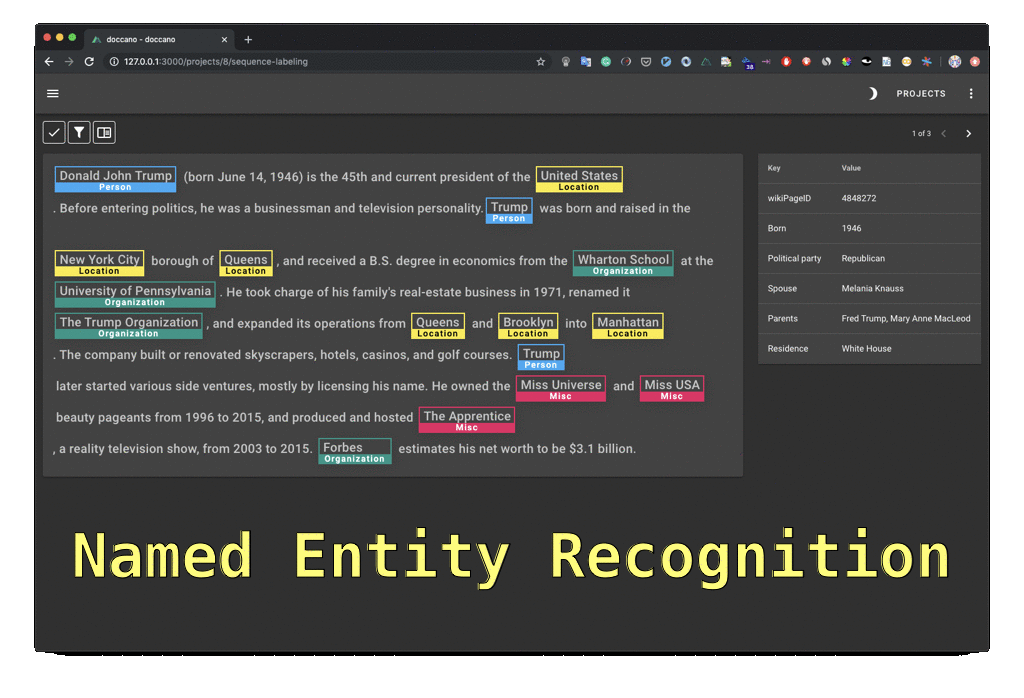doccano, text annotation tool for machine learning practitioners
Project description

doccano
doccano is an open source text annotation tool for humans. It provides annotation features for text classification, sequence labeling and sequence to sequence tasks. So, you can create labeled data for sentiment analysis, named entity recognition, text summarization and so on. Just create a project, upload data and start annotating. You can build a dataset in hours.
Demo
You can try the annotation demo.
Features
- Collaborative annotation
- Multi-language support
- Mobile support
- Emoji :smile: support
- Dark theme
- RESTful API
Usage
Three options to run doccano:
- pip(experimental)
- Docker
- Docker Compose
- production
- development
For docker and docker compose, you need to install the following dependencies:
pip installation
To install doccano, simply run:
pip install doccano
After installation, run the following commands:
# Initialize database.
doccano init
# Create a super user.
doccano createuser --username admin --password pass
# Start a web server.
doccano webserver --port 8000
In another terminal, run the following command:
# Start the task queue to handle file upload/download.
doccano task
Go to http://127.0.0.1:8000/.
By default, sqlite3 is used for the default database. If you want to use PostgreSQL, install the additional dependency:
pip install 'doccano[postgresql]'
Create an .env file with variables in the following format, each on a new line:
POSTGRES_USER=doccano
POSTGRES_PASSWORD=doccano
POSTGRES_DB=doccano
Then, pass it to docker run with the --env-file flag:
docker run --rm -d \
-p 5432:5432 \
-v postgres-data:/var/lib/postgresql/data \
--env-file .env \
postgres:13.3-alpine
And set DATABASE_URL environment variable:
# Please replace each variable.
DATABASE_URL=postgres://${POSTGRES_USER}:${POSTGRES_PASSWORD}@localhost:5432/${POSTGRES_DB}?sslmode=disable
Now run the command as before:
doccano init
doccano createuser --username admin --password pass
doccano webserver --port 8000
# In another terminal.
# Don't forget to set DATABASE_URL
doccano task
Docker
As a one-time setup, create a Docker container as follows:
docker pull doccano/doccano
docker container create --name doccano \
-e "ADMIN_USERNAME=admin" \
-e "ADMIN_EMAIL=admin@example.com" \
-e "ADMIN_PASSWORD=password" \
-p 8000:8000 doccano/doccano
Next, start doccano by running the container:
docker container start doccano
To stop the container, run docker container stop doccano -t 5.
All data created in the container will persist across restarts.
Go to http://127.0.0.1:8000/.
Docker Compose
You need to clone the repository:
git clone https://github.com/doccano/doccano.git
cd doccano
Note for Windows developers: Be sure to configure git to correctly handle line endings or you may encounter status code 127 errors while running the services in future steps. Running with the git config options below will ensure your git directory correctly handles line endings.
git clone https://github.com/doccano/doccano.git --config core.autocrlf=input
Then, create an .env file with variables in the following format(see ./config/.env.example):
# platform settings
ADMIN_USERNAME=admin
ADMIN_PASSWORD=password
ADMIN_EMAIL=admin@example.com
# rabbit mq settings
RABBITMQ_DEFAULT_USER=doccano
RABBITMQ_DEFAULT_PASS=doccano
# database settings
POSTGRES_USER=doccano
POSTGRES_PASSWORD=doccano
POSTGRES_DB=doccano
Production
After running the following command, access http://0.0.0.0/.
docker-compose -f docker-compose.prod.yml --env-file ./config/.env.example up
Development
After running the following command, access http://127.0.0.1:3000/. If you want to use the admin site, please access http://127.0.0.1:8000/admin/.
docker-compose -f docker-compose.dev.yml --env-file ./config/.env.example up
You can run the the test codes for the backend with the following command:
docker exec doccano_backend_1 python backend/manage.py test api
One-click Deployment
| Service | Button |
|---|---|
| AWS[^1] |  |
| Heroku |  |
[^1]: (1) EC2 KeyPair cannot be created automatically, so make sure you have an existing EC2 KeyPair in one region. Or create one yourself. (2) If you want to access doccano via HTTPS in AWS, here is an instruction.
FAQ
See the documentation for details.
Contribution
As with any software, doccano is under continuous development. If you have requests for features, please file an issue describing your request. Also, if you want to see work towards a specific feature, feel free to contribute by working towards it. The standard procedure is to fork the repository, add a feature, fix a bug, then file a pull request that your changes are to be merged into the main repository and included in the next release.
Here are some tips might be helpful. How to Contribute to Doccano Project
Citation
@misc{doccano,
title={{doccano}: Text Annotation Tool for Human},
url={https://github.com/doccano/doccano},
note={Software available from https://github.com/doccano/doccano},
author={
Hiroki Nakayama and
Takahiro Kubo and
Junya Kamura and
Yasufumi Taniguchi and
Xu Liang},
year={2018},
}
Contact
For help and feedback, please feel free to contact the author.
Project details
Release history Release notifications | RSS feed
Download files
Download the file for your platform. If you're not sure which to choose, learn more about installing packages.














